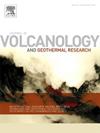Melt generation and magma storage conditions of primitive arc lavas in the Macolod Corridor, southwestern Luzon arc, Philippines
IF 2.4
3区 地球科学
Q2 GEOSCIENCES, MULTIDISCIPLINARY
Journal of Volcanology and Geothermal Research
Pub Date : 2024-10-10
DOI:10.1016/j.jvolgeores.2024.108206
引用次数: 0
Abstract
Decoding the origin of primitive arc magmas from petrological, geochemical, and thermobarometric constraints is crucial for understanding their melt generation process and crustal storage conditions. In the Philippine arc setting, primitive basalts have been recognized in the Macolod Corridor, southwestern Luzon arc. The Macolod Corridor is a 30 by 60-km northeast-southwest striking, young rift system that hosts several Quaternary stratovolcanoes including the active Taal Volcano and Mt. Banahaw, lava domes, and ∼ 200 monogenetic centers classified as scoria cones, tuff cones, tuff rings, and maars. This study reports textural, petrological, and geochemical analyses of the Macolod primitive basalts to decipher their petrogenesis and elucidate their pre-eruptive magma storage conditions. We identified at least five distinct primitive lava compositions based on their modal mineralogy: clinopyroxene-olivine basalts, plagioclase-olivine-clinopyroxene basalts, olivine-plagioclase-clinopyroxene basalts, clinopyroxene-plagioclase-olivine basalts, and clinopyroxene-olivine-plagioclase basalts. Clinopyroxene-olivine basalts and clinopyroxene-plagioclase-olivine basalts occur as lapilli and bomb deposits. In contrast, plagioclase-olivine-clinopyroxene-basalts, olivine-plagioclase-clinopyroxene basalts, and clinopyroxene-olivine-plagioclase basalts occur as lapilli and volcanic bombs in monogenetic volcanoes and as basaltic blocky lava flows in small polygenetic volcanoes. Phenocrysts, glomerocrysts, and microphenocrysts assemblages include olivine, clinopyroxene, plagioclase ± spinel in a glassy matrix. The basalts are identified as subalkaline, medium-K, and medium-Fe tholeiitic basalts, based on their bulk-rock geochemistry. Adding 3–4 % equilibrium olivine to the Macolod primitive basalts generates magmas in equilibrium with mantle olivines with Fo90.68–90.82 and 0.392–0.395 wt% NiO compositions. Disequilibrium textures exhibited by olivines, clinopyroxenes, and plagioclases suggest that these are products of magma decompression and dissolution processes. Calculated melt based on olivines reveals that these primitive magmas last equilibrated at depths ranging from ∼36–42 km (1.03–1.23 GPa) at 1286°–1318 °C. Application of clinopyroxene-only thermobarometer results indicate clinopyroxene crystallization depths of around 7–16 and 10–19 km for hydrous and anhydrous estimates, respectively. The segregation depths estimated in this study translate to the uppermost mantle until near the Moho boundary whereas the storage depths correspond to prolonged magma storage regions in the upper crust as modeled by existing geophysical data (i.e., seismic travel-time tomography). Combining textural and geochemical results from this study with existing geophysical data provides new insights into the magma plumbing systems in the region and how these might operate through time.
菲律宾吕宋岛弧西南部马科洛德走廊原始弧熔岩的熔融生成和岩浆储存条件
从岩石学、地球化学和热压计量学的约束条件来解码原始弧岩浆的起源,对于了解其熔融生成过程和地壳储存条件至关重要。在菲律宾弧环境中,原始玄武岩已在吕宋岛弧西南部的马科洛德走廊得到确认。马科洛德走廊是一个东北-西南走向、长 30-60 公里的年轻裂谷系统,这里有多座第四纪平流火山,包括活跃的塔尔火山和巴纳霍山、熔岩穹丘,以及 200 多个单生中心,分为焦岩锥、凝灰岩锥、凝灰岩环和火山口。本研究报告对马科洛德原始玄武岩进行了纹理、岩石学和地球化学分析,以破译其成岩过程并阐明其爆发前的岩浆储存条件。根据其模式矿物学,我们确定了至少五种不同的原始熔岩成分:霞石-橄榄石玄武岩、斜长石-橄榄石-霞石-斜长石玄武岩、霞石-斜长石-橄榄石玄武岩和霞石-橄榄石-斜长石玄武岩。linopyroxene-橄榄石玄武岩和linopyroxene-斜长石-橄榄石玄武岩以青灰岩和炸弹沉积的形式出现。相比之下,斜长石-橄榄石-斜长石-辉石玄武岩、橄榄石-斜长石-辉石玄武岩和斜长石-橄榄石-斜长石玄武岩在单源火山中以青灰岩和火山弹的形式出现,在小型多源火山中则以玄武岩块状熔岩流的形式出现。表晶、团晶和微表晶集合体包括玻璃基质中的橄榄石、倩辉石、斜长石和尖晶石。根据其块状岩石地球化学特征,这些玄武岩被确定为亚碱性、中K和中铁托勒密玄武岩。在马科洛德原始玄武岩中加入3-4%的平衡橄榄石,可生成与地幔橄榄石平衡的岩浆,其成分为Fo90.68-90.82和0.392-0.395 wt% NiO。橄榄石、挛辉石和斜长石表现出的非平衡纹理表明,这些是岩浆减压和溶解过程的产物。根据橄榄石计算的熔体显示,这些原始岩浆最后平衡的深度为 ∼ 36-42 km(1.03-1.23 GPa),温度为 1286°-1318 °C。应用clinopyroxene-only温度计的结果表明,无水和无水估计的clinopyroxene结晶深度分别约为7-16和10-19千米。本研究估算的偏析深度为最上层地幔直至莫霍边界附近的深度,而贮存深度则与现有地球物理数据(即地震走时层析成像)模拟的上地壳岩浆长期贮存区相对应。将这项研究的纹理和地球化学结果与现有地球物理数据相结合,可以对该地区的岩浆管道系统以及这些系统如何随着时间的推移而运作提供新的见解。
本文章由计算机程序翻译,如有差异,请以英文原文为准。
求助全文
约1分钟内获得全文
求助全文
来源期刊
CiteScore
5.90
自引率
13.80%
发文量
183
审稿时长
19.7 weeks
期刊介绍:
An international research journal with focus on volcanic and geothermal processes and their impact on the environment and society.
Submission of papers covering the following aspects of volcanology and geothermal research are encouraged:
(1) Geological aspects of volcanic systems: volcano stratigraphy, structure and tectonic influence; eruptive history; evolution of volcanic landforms; eruption style and progress; dispersal patterns of lava and ash; analysis of real-time eruption observations.
(2) Geochemical and petrological aspects of volcanic rocks: magma genesis and evolution; crystallization; volatile compositions, solubility, and degassing; volcanic petrography and textural analysis.
(3) Hydrology, geochemistry and measurement of volcanic and hydrothermal fluids: volcanic gas emissions; fumaroles and springs; crater lakes; hydrothermal mineralization.
(4) Geophysical aspects of volcanic systems: physical properties of volcanic rocks and magmas; heat flow studies; volcano seismology, geodesy and remote sensing.
(5) Computational modeling and experimental simulation of magmatic and hydrothermal processes: eruption dynamics; magma transport and storage; plume dynamics and ash dispersal; lava flow dynamics; hydrothermal fluid flow; thermodynamics of aqueous fluids and melts.
(6) Volcano hazard and risk research: hazard zonation methodology, development of forecasting tools; assessment techniques for vulnerability and impact.

 求助内容:
求助内容: 应助结果提醒方式:
应助结果提醒方式:


